Top tips for designing revegetation for native birds
There are over 800 species of birds in Australia, about a third of which depend on woodlands to survive. Across the sheep-wheat belt of Australia, woodland bird numbers are rapidly declining, with one in five of these species threatened with extinction.
The good news is that we can turn things around by designing revegetation for native birds. Keep reading for our top tips on how to do it.
Why design revegetation for native birds?
Our native flora and fauna evolved together and are interdependent. Birds depend on trees for shelter, nesting, perching and food. In turn, many tree species need native birds for insect control, seed dispersal and pollination.
Humans need birds for the services they provide as well.
There are over 86,000 species of insects in Australia, and birds provide free, safe and highly effective pest control services. Healthy bird communities can remove half to two-thirds of leaf-gobbling insects within tree patches, protecting vital vegetation growing on farms.
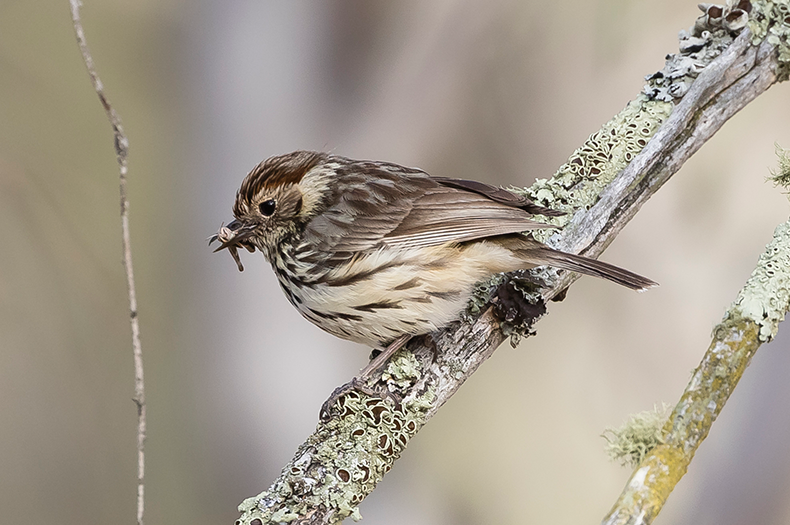
Birds like this Speckled Warbler (caught mid-meal) provide important insect control services. Photo credit: Sandra Lauer.
Strolling through a healthy, good-sized patch of native vegetation, loud and alive with birds busy with work and play, is also just great for wellbeing.
Long and short, designing revegetation for native birds is caring for our landscapes and for ourselves at the same time.
How can we tell if revegetation is providing habitat for native birds?
Woodland birds are disappearing because habitat is being lost from the landscape – one third of Australia’s woodlands (and 80% of Australia’s temperate woodlands) have been cleared. This can be turned around by protecting remnants and restoring habitat, particularly by integrating appropriate native plantings into agricultural landscapes.
But how do we know revegetation is providing habitat? The birds tell us! For example, when surveying revegetation sites for native birds, seeing species which feed on the ground (such as robins and choughs) is a positive indicator that healthy ground cover is establishing.
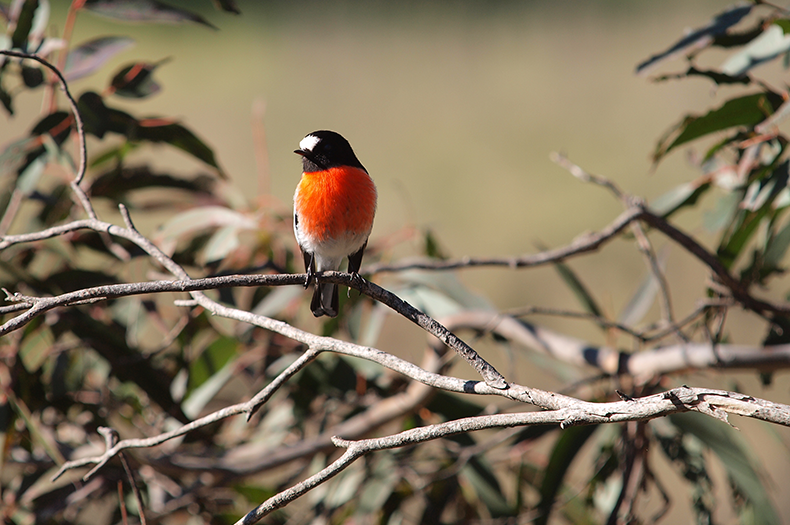
The vulnerable Scarlet Robin forages from low perches, fence-posts or on the ground, pouncing on small insects and other invertebrates. Photo credit: Eric Wenger.
The presence of predatory birds (such as owls, hawks and kites) or parasitic birds (such as cuckoos) indicates that the area is supporting a growing population of smaller birds.
Development of hollows takes time, so the presence of hollow-dwelling birds indicates that the patch of vegetation is providing mature, complex habitat.
Our top tips for designing revegetation for native birds
Design considerations such as the size, shape, structure, composition and connectivity of revegetation can be used to maximise habitat and bring birds back into the landscape.
In our experience, even small, isolated patches of revegetation (even backyards!) can provide some habitat and lay a foundation for birds returning. We’ve seen some model bird havens that grew from totally cleared landscapes, so make a start and see what happens!
Here are eight of our top tips for designing revegetation for native birds.
1. Protect existing remnant native vegetation.
Existing or remnant native vegetation often represents the highest quality habitat in the landscape, so protecting whatever you already have on your property is a vital first step.
Fence existing native vegetation to protect it from overgrazing and compaction. Revitalise degraded remnants by establishing understorey species. Revegetate around remnants to increase their size and connect them to other patches.
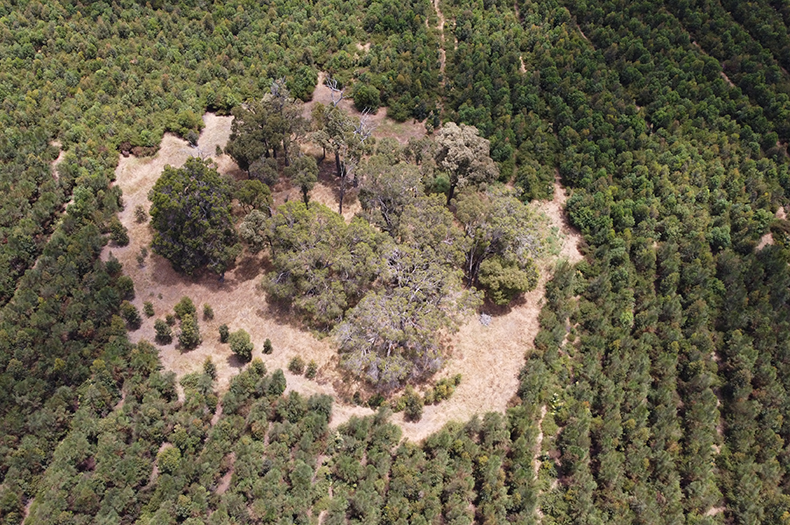
You can protect existing remnant trees that provide highly valuable bird habitat by revegetating around them, as we’ve done with this planting in Western Australia.
2. Plant as large a site as you can (or add to existing patches).
We know that larger remnant patches contain more species of bird than smaller patches, so the best way to entice more native birds is to plant large areas of revegetation, or enlarge existing areas.
For example, in surveys of revegetation sites in the Capital region, an average windbreak of three rows (~12 metres wide) supported 11 species of woodland birds, while in windbreaks of five rows (~25 metres wide) the number of common woodland bird species increased to 17.
‘Bigger is better’ is a great rule of thumb. But if there’s a specific bird species you’d like to support, read up on any territory requirements they may have for breeding or feeding – territory size is one of the key reasons that larger patches can support more bird species. For example, even tiny thornbills need 0.5 – 2.5 hectares of habitat for a breeding territory.
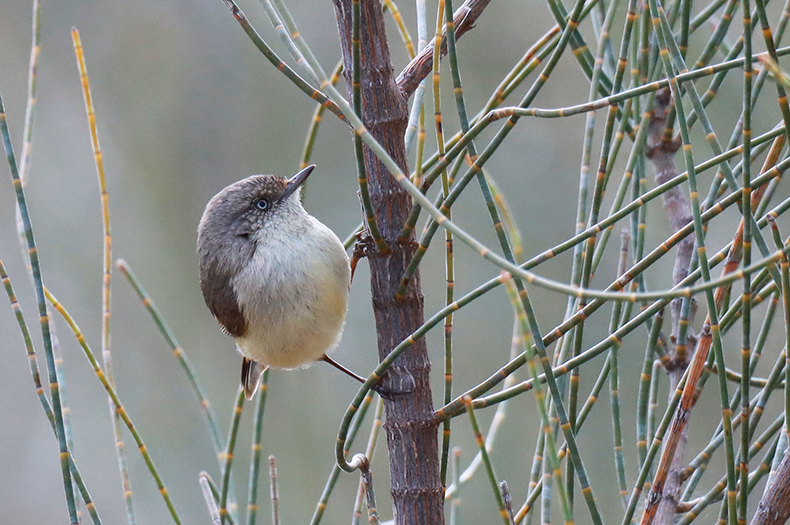
The Buff-rumped Thornbill ‘doesn’t even work out’. These tiny birds are often seen in groups of around 20 and, like many species, are territorial. Photo credit: Jennifer Goldsworthy.
3. Connect sites with wide corridors or create ‘stepping stones’.
What sort of ‘neighbourhood’ is your revegetation site in? Generally, the greater the amount of vegetation in the area around the site, the more bird species you’re likely to see moving in.
Looking at neighbouring areas is key for ensuring your revegetation plays to the strengths of the surrounding landscape and improves habitat function for birds.
For example, some woodland birds avoid crossing open farmland: young White-browed Babblers may disperse 1 – 4 kilometres to find a new territory, but they will rarely travel more than 20 metres away from tree or shrub cover.
Your design can provide these birds with well-connected vegetation, e.g. by planting wide corridors that link remnant areas of bushland. A word of caution, though, against creating corridors that lead nowhere – dead-ends can become ecological death traps.
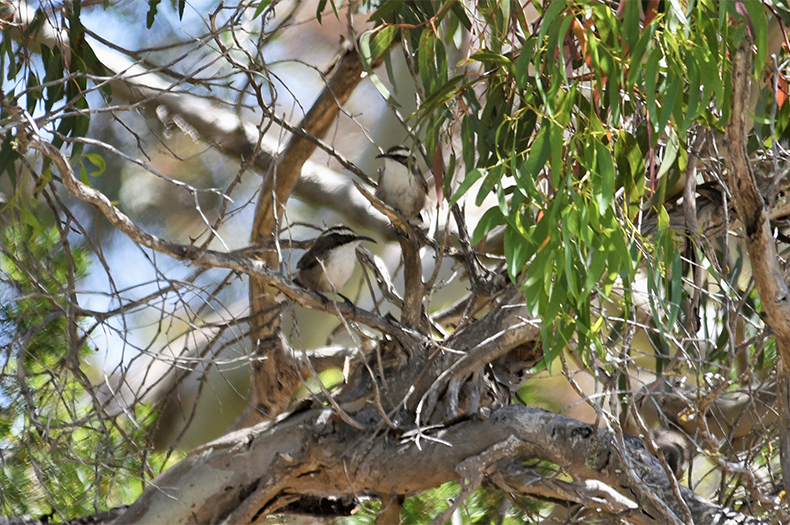
One of our team snapped these excellently camoflauged White-browed Babblers while on a monitoring visit of revegetation at our Morella project in SA.
Some bird species will cross a certain distance of open farmland and can then use vegetation patches as ‘stepping stones’ to travel longer distances. To support their movement, your design could include planted patches or protected paddock trees spaced between larger remnant or revegetated patches.
If you’re starting to plant in a mostly treeless neighbourhood, best results will be achieved if the site is large, 10 hectares or greater in size.
4. Establish a diversity of local native species.
Use locally native plant species, because they are already adapted to your local soils and climate and have evolved with the local native wildlife.
Also try to use tree, shrub and grass species suited to the specific planting location, e.g. different species grow on ridgetops and hillsides compared to creeks and low-lying areas.
You can use nearby remnant vegetation as a ‘reference ecosystem’ to guide your choices and as inspiration for your end goal.
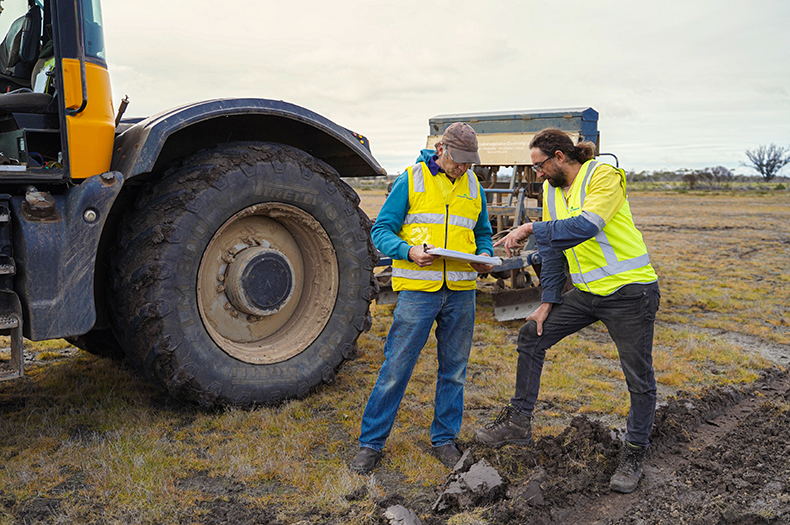
A lot of factors contribute to successfully establishing revegetation for native birds – plant choice is one, but giving the plants the best start also involves considering such things as row/plant spacing, timing and method of planting, soil preparation, weed and pest control.
Once you’ve chosen the species, plan out all the factors that contribute to establishing a successful revegetation site, such as soil preparation, spacing of seeding rows/seedlings, timing of planting, weed and pest control, fencing or guards, watering etc.
The planting method should match your site conditions to give your revegetation the best start. For example, where sites are large and soils permit use of machinery (e.g. former agricultural land), then direct seeding is a successful and highly efficient option.
Where soils, terrain and climate are more challenging (rocky, steep, dry), planting tubestock (seedlings) may be more successful. A blend of the two methods is often appropriate where conditions sit somewhere between the two extremes.
5. Know your birds and the resources they need.
Which birds should be in your area, and what do they need in terms of food and shelter? A commonly held view of ‘bird-attracting plants’ is that they need to be big, bright, nectar-filled flowering natives such as grevilleas, banksias and bottlebrushes (Callistemon spp.).
These nectar-rich natives certainly attract birds, but planting too many can lead to an over-abundance of large aggressive honeyeaters such as wattlebirds and Noisy Miners. These birds hate competition and drive away smaller birds, even those that don’t eat nectar!
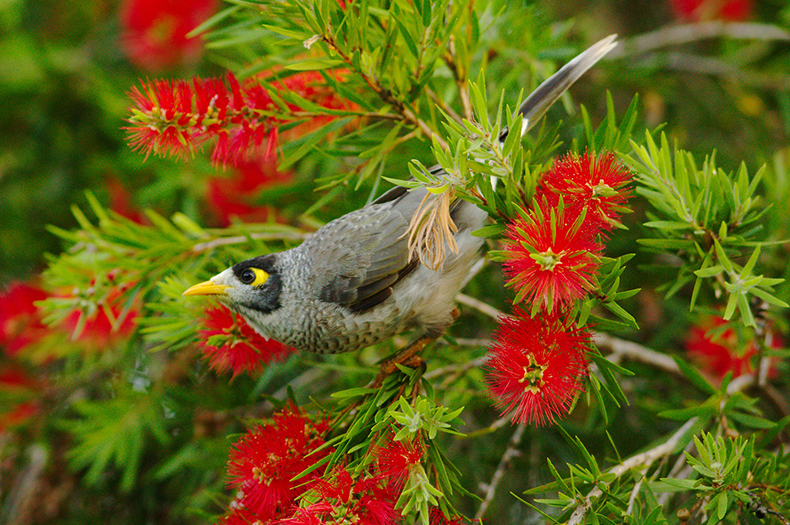
High numbers of the bold and adaptable Noisy Miner, an endemic honeyeater, can displace other woodland birds, so it’s important to get the balance right and not overplant nectar-rich natives in revegetation. Photo credit: Klaus Stiefel CC BY-NC 2.0
Aim to include a balanced diversity of local native plants in your planting site that provide seeds, fruit and nectar, and that attract insects (an important food source for many birds!). You may also want to consider including habitat nodes in your design – that is, areas of specific plant species for specific bird habitat purposes, e.g. planting an area with proteaceous food species for foraging cockatoos.
Don’t forget to consider seasonal resource availability too – aim for a mix of species that provide resources at different times of the year so there’s something to feed on all year round.
For insect-eating birds, plant smaller flowering species that attract insects, like wattles (Acacia spp.), tea-trees (Leptospermum spp.), native peas, native daisies and native bluebells.
For little seed-eaters like finches and ground-feeding birds like Buff-rumped Thornbill, plant native grasses and leave leaf litter and dead wood in place.
To encourage larger birds like magpies, currawongs and kookaburras, think about providing habitat for reptiles, small mammals, insects and other invertebrates.
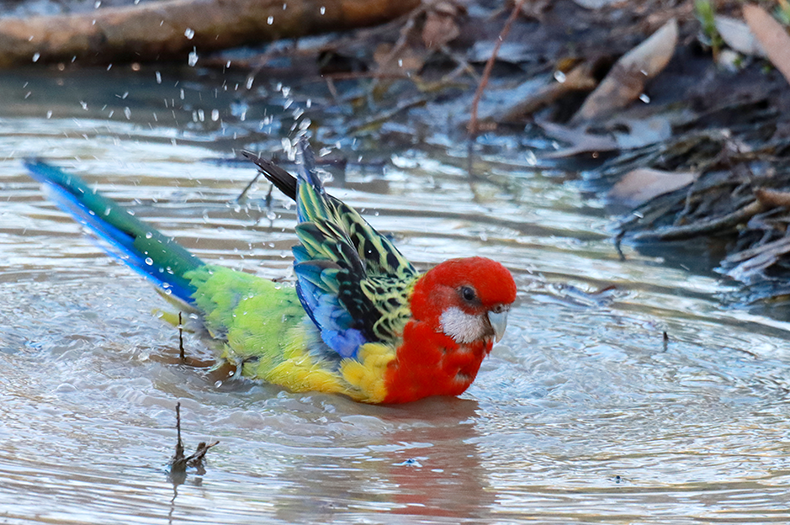
A water source is also a great attraction for birds and will be used by many different species. Considering water access in revegetation design is increasingly important in our drying climate. Photo credit: Jennifer Goldsworthy.
6. Plan for variety and patchiness in the structure of your revegetation.
Structural diversity in your revegetation will provide for the greatest range of birds. Include different growth forms of trees, shrubs, native grasses, climbers and other plants, and where possible, allow for important non-living structural habitat such as rocks, logs, leaf litter and even patches of bare ground.
In forest, woodland and mallee habitats, birds also need ‘patchiness’ in structure: both the cover of dense shrubs and trees to nest in, and open areas (internal space) to feed in.
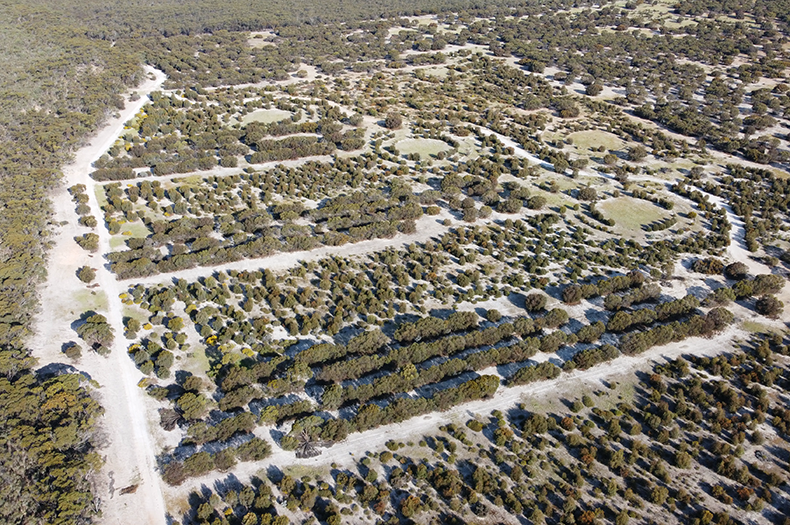
The revegetation at Nowanup in WA, designed in consultation with local experts and Traditional Owners, incorporates ecocultural spaces (yarning circles with varied plant species), which also function as internal spaces for native birds.
Internal space is particularly important for ground-feeding species, such as robins, and can be simply achieved in revegetation by:
- spacing planting rows by between 5-10 metres apart
- putting two rows close together, then leaving a 10-metre gap to the next row
- leaving out a middle row
- leaving inadvertent gaps, for example if small sections of seeding don’t germinate, rather than filling these gaps with more trees and shrubs.
Even at smaller scales, for example in a backyard, the structure of a planting can mimic a clearing in a forest for woodland birds. This may be as simple as planting several different-sized trees around a lawn or paved area, then planting shrubs and grasses around the sides.
7. Leave branches where they fall.
Coarse woody debris provides valuable habitat, particularly for insect-eating bird species and birds of prey, so where possible it’s best to leave branches and leaves where they fall. If logs or branches really need to be ‘tidied up’, the ideal is to still repurpose them for habitat e.g. by placing them in the revegetation site to provide habitat for wildlife. Avoid creating piles of logs though, as this may encourage use by pests such as rabbits.
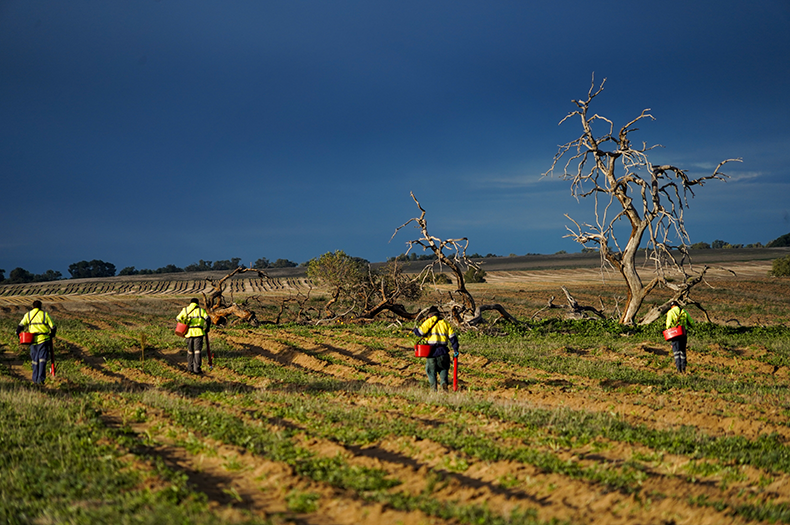
Planting around standing dead trees and fallen timber in your revegetation site is a quick win for bird habitat. Photo credit: Jesse Collins.
8. Let it grow. Bird numbers increase with the age of the site.
The first birds will start inhabiting a revegetation site from two years of age onwards. As sites get older and trees get taller, many ecological functions start to develop. Flowers and seeds are produced, different understorey layers develop, native grasses and herbs regenerate, and a litter layer – including invertebrates – develops, which increases the number of species that can make a home there.
Further reading
- Research shows planting trees and shrubs brings woodland birds back to farms
- Assessing the conservation benefits of revegetation (includes factsheet series on revegetation in farm landscapes)
- Bringing birds back: a glovebox guide for bird identification and habitat restoration in ACT and SE NSW
- Role of revegetation as habitat for birds: A case study of four revegetation localities in rural South Australia (including Greening Australia’s Morella site)
- The potential of revegetation programs to encourage invertebrates and insectivorous birds (WA study)
- How to create a bird-friendly garden
Want to partner with us on a revegetation project for your property? Register your interest and we’ll call to discuss options with you.
Want to get articles like this delivered to your inbox? Subscribe to our news.